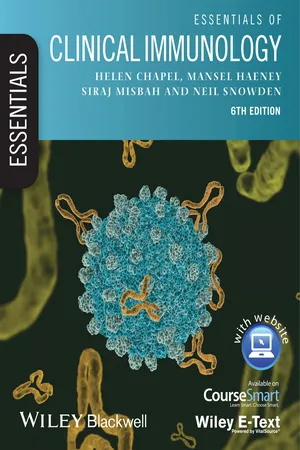
Essentials of Clinical Immunology
- English
- ePUB (mobile friendly)
- Available on iOS & Android
Essentials of Clinical Immunology
About this book
Essentials of Clinical Immunology provides the most up-to-date, core information required to understand diseases with an immunological basis. Clinically focussed, the sixth edition of this classic text presents theoretical and practical information in a simple yet thorough way.
Essentials of Clinical Immunology covers the underlying pathophysiology, the signs and symptoms of disease, the investigations required and guidance on the management of patients.
Perfect for clinical medical students, junior doctors and medical professionals seeking a refresher in the role of immunology in clinical medicine, this comprehensive text features fully updated clinical information, boxes with key points, real-life case histories to illustrate key concepts and an index of contents at the start of each chapter.
A companion website at www.immunologyclinic.com provides additional learning tools, including more case studies, interactive multiple-choice questions and answers, all of the photographs and illustrations from the book, links to useful websites, and a selection of review articles from the journal Clinical and Experimental Immunology.
This title is also available as a mobile App from MedHand Mobile Libraries. Buy it now from iTunes, Google Play or the MedHand Store.
Frequently asked questions
- Essential is ideal for learners and professionals who enjoy exploring a wide range of subjects. Access the Essential Library with 800,000+ trusted titles and best-sellers across business, personal growth, and the humanities. Includes unlimited reading time and Standard Read Aloud voice.
- Complete: Perfect for advanced learners and researchers needing full, unrestricted access. Unlock 1.4M+ books across hundreds of subjects, including academic and specialized titles. The Complete Plan also includes advanced features like Premium Read Aloud and Research Assistant.
Please note we cannot support devices running on iOS 13 and Android 7 or earlier. Learn more about using the app.
Information
- 1.1 Introduction
- 1.2 Key molecules
- 1.2.1 Molecules recognized by immune systems
- 1.2.2 Recognition molecules
- 1.2.3 Accessory molecules
- 1.2.4 Effector molecules for immunity
- 1.2.5 Receptors for effector functions
- 1.2.6 Adhesion molecules
- 1.3 Functional basis of innate responses
- 1.3.1 Endothelial cells
- 1.3.2 Neutrophil polymorphonuclear leucocytes
- 1.3.3 Macrophages
- 1.3.4 Dendritic cells
- 1.3.5 Complement
- 1.3.6 Antibody-dependent cell-mediated cytotoxicity
- 1.3.7 Natural killer cells
- 1.4 Functional basis of the adaptive immune responses
- 1.4.1 Antigen processing
- 1.4.2 T cell mediated activation responses
- 1.4.3 Antibody production
- 1.5 Physiological outcomes of immune responses
- 1.5.1 Killing of target cells (virally infected/tumour cells)
- 1.5.2 Direct functions of antibody
- 1.5.3 Indirect functions of antibody
- 1.5.4 Regulation
- 1.6 Tissue damage caused by the immune system
- 1.6.1 Inflammation: a brief overview
- 1.7 Organization of the immune system: an overview
- 1.8 Conclusions

1.1 Introduction
| Features | Innate | Adaptive |
|---|---|---|
| Foreign molecules recognized | Structures shared by microbes, recognized as patterns (e.g. repeated glycoproteins) PAMPs | Wide range of very particular molecules or fragments of molecules on all types of extrinsic and modified self structures |
| Nature of recognition receptors | Germline encoded – limited PRRs | Somatic mutation results in wide range of specificities and affinities |
| Speed of response | Immediate | Time for cell movement and interaction between cell types |
| Memory | None | Efficient |
| Humoral components | Complement components | Antibodies |
| Cellular components | Dendritic cells, neutrophils, macrophages, NK cells, NKT cells, B1 cells, epithelial cells, mast cells | Lymphocytes – T (Th1, Th2, Th17, T regs) B |
| iNKT cells, γδ T cells | ||

1.2 Key molecules
1.2.1 Molecules recognized by immune systems
Table of contents
- Cover
- Title page
- Copyright page
- Preface to the Sixth Edition
- Preface to the First Edition
- How to Use Your Textbook
- About the Companion Website
- Key to Illustrations
- Chapter 1
- Chapter 2: Infection
- Chapter 3: Immunodeficiency
- Chapter 4: Anaphylaxis and Allergy
- Chapter 5: Autoimmunity
- Chapter 6: Lymphoproliferative Disorders
- Chapter 7: Immune Manipulation
- Chapter 8: Transplantation
- Chapter 9: Kidney Diseases
- Chapter 10: Joints and Muscles
- Chapter 11: Skin Diseases
- Chapter 12: Eye Diseases
- Chapter 13: Chest Diseases
- Chapter 14: Gastrointestinal and Liver Diseases
- Chapter 15: Endocrinology and Diabetes
- Chapter 16: Non-Malignant Haematological Diseases
- Chapter 17: Neuroimmunology
- Chapter 18: Immunological Diseases in Pregnancy
- Chapter 19: Techniques in Clinical Immunology
- Appendix: Further Resources
- Index